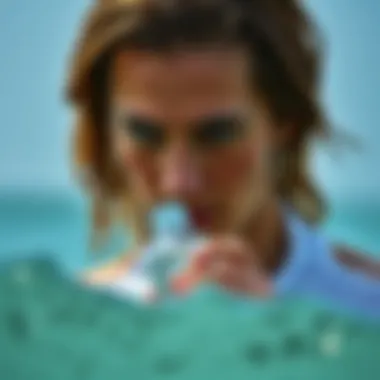Effective Ways to Assess Your Hydration Levels


Intro
Staying hydrated might seem like a simple task, but for surfers, it's far from straightforward. You can spend hours riding waves, and the sun beating down doesn’t help either. Assessing hydration levels becomes a critical aspect of not just staying healthy, but also performing at your best on the board.
Let’s face it, when you're in the water, the last thing on your mind is probably how much water you're drinking. It's often overshadowed by the thrill of catching that perfect wave or mastering a new trick. Yet, hydration isn't just important; it’s essential. Dehydration can impact both your physical performance and cognitive function, making it harder to focus and react swiftly. In this guide, we’ll discuss methods to assess your hydration, recognize signs of dehydration, and share tips tailored specifically for surfers.
This isn’t just about drinking more water; it's about understanding your body’s unique needs and adapting to the conditions around you. So grab your surfboard, and let's dive in!
Understanding Hydration
Hydration is often brushed aside as merely a matter of drinking water, but the nuances run much deeper than surface-level understanding. Recognizing the balance of fluids in the body affects everything from performance during physical activities to mental acuity in daily tasks. Especially pertinent for surfers, instructors, and those engaging in beach sports, fluid maintenance is critical to maximizing performance and enjoyment of the ocean.
Definition of Hydration
Hydration refers to the process through which the body maintains an appropriate balance of fluids, ensuring that each cell operates efficiently. Water makes up about 60% of the human body, playing a vital role in various physiological processes, including temperature regulation, nutrient transportation, and waste elimination. When you dive into the ocean, the body loses water through various means – sweating while paddling, breathing in salty air, and even through skin absorption. This highlights why understanding hydration isn't just beneficial; it's essential.
Importance of Hydration in Physical Activity
In the realm of physical exertion, proper hydration is often the unsung hero. As muscles contract during activities like surfing, they release metabolic waste and heat. If hydration levels slide, performance can noticeably dip, leaving a surfer struggling to catch waves or maintain balance. Clinical studies bolster this claim, showing that even mild dehydration can impair endurance, strength, and overall functionality. Surfers need to pay attention to how they feel – fatigue, dizziness, and decreased coordination signal that hydration levels may have taken a hit.
Hydration and Cognitive Performance
Mental sharpness is just as crucial as physical readiness, especially in fast-paced sports where split-second decisions can make or break a wave ride. Cognitive functions such as concentration, memory, and reaction times can be negatively impacted by dehydration. Research indicates that dehydration can cause a notable decline in cognitive skills, not merely causing headaches or fatigue but affecting the overall ability to perform critical tasks. Surfers often have to remain vigilant, juggling the dynamic conditions of the sea and the necessity of staying hydrated to keep both mind and body in tip-top shape.
"A well-hydrated surfer is not just better prepared for the waves, but also sharper in decision-making, crucial for rides full of unexpected twists and turns."
By integrating sound hydration practices into daily routines, one fosters both physical and cognitive resilience. Whether it's sipping electrolyte fluids post-surf or setting reminders to drink water regularly, these can lead to a significant transformation—not just for performance but for general well-being. In hot climates or when surfing during peak sun hours, awareness of hydration levels can mean the difference between a good day on the water and an exhausting struggle.
Signs of Dehydration
Recognizing the signs of dehydration is essential, especially for those engaging in physically demanding activities like surfing. Dehydration not only hampers performance but can also lead to more serious health risks. Therefore, understanding what to look for can make a significant difference in staying healthy and maintaining optimal performance levels.
Physical Symptoms
When your body lacks enough fluids, it often communicates this through physical symptoms. Common indicators include:
- Dry mouth and throat: You might notice a parched feeling, making swallowing uncomfortable.
- Fatigue: A drop in energy can leave you feeling like you've just run a marathon, even if you've only been sitting on the beach.
- Headaches: Many people experience headaches as a clear sign of dehydration. This can create a frustrating barrier to enjoying your day.
- Dizziness: A lack of sufficient fluids can lead to lightheadedness, which is vital to recognize, especially when you are near water.
- Muscle cramps: This can often be felt after extended periods without hydration.
Paying attention to these physical symptoms is crucial. They act like signals that your body is sending out, waving a red flag to remind you to hydrate.
Behavioral Indicators
Behavioral changes can also signal that your hydration levels are off. These might not be as obvious as physical signs, but they are just as important. They include:
- Increased thirst: If you find yourself reaching for water more often, it’s a clear cue your body needs hydration.
- Irritability: You might feel more frustrated or short-tempered, often a sign that you’re not feeling your best.
- Confusion or difficulty concentrating: This can really affect your performance, whether in the water or on the shore. Finding your focus might become harder.
- Decreased urine output: If you're heading to the restroom less frequently than usual, your body might be conserving water.
Recognizing these behavioral shifts can help you stay one step ahead. In a sport where clarity and focus are crucial, staying hydrated plays an active role in how you feel mentally and physically.
Assessment through Urine Color
The color of your urine can serve as a straightforward indicator of your hydration status. This method is easy to implement, involves no additional tools, and provides immediate feedback on how well you’re hydrating.
- Clear or light yellow: This typically indicates good hydration levels.
- Dark yellow or amber: This suggests a need for more fluids. If your urine resembles this color, you should take it as a signal to drink water immediately.
- Brown or tea-colored: This is a warning sign and usually points to severe dehydration, which requires immediate action.


"Always aim for pale yellow – it’s your hydration goal!"
Using urine color as a hydration gauge is quite handy, especially when you're on the go. Being aware of this can help in managing fluid intake throughout your surfing sessions and beyond.
Understanding these signs—both physical and behavioral—along with utilizing urine color as a hydrating tool plays a vital role in maintaining your hydration levels effectively. This creates a solid foundation for enhanced performance on and off the waves, ensuring that you can enjoy every ride without feeling the effects of dehydration.
Methods for Testing Hydration Levels
Understanding how to gauge your hydration levels is crucial, especially if you’re embraced by the sea’s alluring waves. Not only does proper hydration enhance your performance on the board, but it also sustains your cognitive alertness while you’re counting down the seconds to catch the next big wave. This section will break down various methods to test your hydration levels, highlighting techniques ranging from self-assessments to advanced tools and professional guidance. By assessing hydration accurately, you’ll be better equipped to meet your body’s needs throughout intense surfing adventures.
Self-Assessment Techniques
One of the simplest ways to check your hydration status is through self-assessment methods. They allow you to gauge your body’s needs without the necessity for high-end tools. Here are a few techniques:
- Thirst Level: This one’s straightforward—how thirsty are you? If your throat feels dry, that’s usually a solid indicator you need to hydrate. But don’t rely solely on this as some people may not feel thirsty until they’re pretty dehydrated.
- Body Check: Perform a quick check on your skin. Pinch the skin on the back of your hand. If it snaps back quickly, you’re likely well-hydrated. If it takes a while to spring back, you might need a drink.
- Mouth Feel: A dry or sticky mouth can also indicate dehydration. When your saliva seems to be taking a vacation, that’s your cue.
Hydration Testing Tools
For those looking to dig a little deeper, hydration testing tools offer a way to assess your hydration in a more scientific manner. Here, we’ll take a look at some popular tools, including hydration monitors and hydration assessment strips.
Hydration Monitors
Hydration monitors have come a long way and can be very useful in understanding your hydration levels. These devices can track your water intake and, in some cases, your body's output.
A key characteristic of hydration monitors is their ability to provide real-time data. Instead of guessing how much water you’ve consumed or how much you need, these monitors offer precise figures. They often sync with smartphones to give detailed insights into your hydration trends over time, which is particularly helpful for surfers who spend long hours in demanding conditions.
One unique feature of hydration monitors is their alerts. Some models buzz or send notifications reminding you to hydrate throughout the day. This is super handy when you're focused on your surfing practice and might forget to drink water. However, one downside is some monitors can be pricey, which might not be ideal for every budget.
Hydration Assessment Strips
Meanwhile, hydration assessment strips are a straightforward and affordable option for monitoring hydration. These strips can measure various indicators in your urine, like electrolyte levels and hydration status.
What stands out about hydration strips is their ease of use. Simply dip the strip into a sample of your urine, wait for a few seconds, and compare the colors against a chart that comes with the strips. It's a fast way to get insights into your hydration level.
However, while these tools are handy, they do come with some caveats. For instance, factors like diet can sometimes skew results. Drinking beet juice or taking certain supplements may change the color of the strip readings. Also, interpretation requires a bit of knowledge, so some trial and error might be involved.
Consulting a Professional
When in doubt, consulting a professional can provide insights tailored to your specific needs. A healthcare provider or a sports nutritionist can evaluate hydration strategies that fit your lifestyle, especially as a surfer. They can assess your overall health, activity level, and even local climate conditions, all of which impact your hydration needs.
In doing so, professionals can offer personalized hydration plans that take into account individual preferences, whether you’re sipping coconut water or your favorite sports drink. This tailored approach is a game-changer, yielding the best hydration success for your surfing performance.
"Hydration is not just about drinking water; it’s a critical aspect of staying strong and energized on the waves."
In summary, assessing hydration levels can be varied—from simple checks at home to advanced technology and professional guidance. Selecting the right method can significantly enhance your performance and health while enjoying the salty breeze and sunshine.
Hydration Strategies for Surfers
Hydration is like the magic ingredient in the recipe for a successful surf day. It's not just about quenching thirst; it's about maintaining peak performance and ensuring safety in the water. For surfers, particularly those spending long hours riding waves, staying hydrated is fundamental. An effective hydration strategy helps keep the body functioning optimally, which is essential for endurance and focus.


Types of Fluids to Consume
Water
Water is the simplest and often the best choice for hydration. Its purity makes it a fundamental player in keeping surfers hydrated. One key characteristic of water is that it’s calorie-free and easily accessible. This makes it a popular choice for anyone, especially surfers who want to avoid unnecessary weight in their gear. The unique feature of water is its ability to be absorbed quickly by the body, ensuring rapid hydration. However, while it is excellent for hydration, water alone might not replenish all the essential electrolytes lost through sweating during intense training or long surf sessions.
Electrolyte Drinks
Electrolyte drinks come into play when the surf session becomes serious. These beverages contain vital minerals like sodium, potassium, and magnesium, which help to restore electrolyte balance. The key characteristic of electrolyte drinks is their ability to hydrate while also replenishing lost salts. This makes them a beneficial choice, especially in hot weather conditions. A unique feature of these drinks is that they can combat muscle cramps, providing an edge in endurance sports. While they do provide significant benefits, one must be cautious about added sugars that might negate their advantages.
Coconut Water
Coconut water stands out as a natural alternative for hydration. It's loaded with potassium and is often referred to as nature's sports drink due to its low calorie and high electrolyte profile. The key characteristic here is its natural origin, making it appealing for health-conscious surfers. A unique feature of coconut water is that it comes with an array of antioxidants, aiding recovery and overall wellness. Yet, despite its benefits, some may find its taste strong or somewhat off-putting after strenuous activity.
Timing Your Hydration
Proper hydration timing is crucial for maximizing performance and minimizing the risk of dehydration. Aim to hydrate well before your surf session, ideally a couple of hours prior. During the session, take sips regularly rather than waiting until you feel thirsty. Post-surf, rehydrating appropriately is essential to recovery and preparedness for future sessions.
Avoiding Dehydration while Surfing
Pre-Surf Hydration
Pre-surf hydration sets the stage for a successful session. Consuming fluids at least 30 minutes before hitting the waves can help ensure the body is in a hydrated state. One aspect to consider here is finding that balance; overloading on fluids might lead to discomfort in the water. The beneficial aspect of pre-surf hydration is the reduced chance of fatigue during your session. The unique feature is that it establishes a healthy baseline for fluid intake, making it a wise choice for both recreational and competitive surfers.
Hydration During Surfing
During surfing, staying proactive about hydration is vital. Small sips of water or electrolyte drinks while taking breaks can help maintain levels. The need to hydrate during surfing comes from the loss of sweat, which can lead to dizziness or fatigue if not managed. A notable characteristic is that surfers often forget to hydrate due to the excitement of catching waves. The advantage of developing a habit of drinking while surfing is that it minimizes the risk of dehydration, keeping physical performance strong and consistent.
Post-Surf Recovery
After a long day on the water, post-surf recovery hydration is essential. It helps restore lost fluids and ensures your body begins the recovery process. One key aspect here is the timing; hydration within the first 30 minutes post-surf is optimum. The unique feature about recovery hydration is that it can enhance muscle repair and overall well-being. However, relying solely on sports drinks might overlook the need for pure water intake, which plays an equally important role.
Ultimately, surf enthusiasts, instructors, and beach lifeguards must prioritize hydration strategies tailored to their activities and environments. In doing so, they will not only enhance their performance on the waves but also safeguard their health.
Long-Term Hydration Practices
Sustaining proper hydration isn't just about chugging water before a beach day or downing electrolyte drinks after a morning surf. Long-term hydration practices can make all the difference, especially for surfers, lifeguards, and anyone who spends significant time outdoors. Building a solid hydration habit over time can enhance physical performance, cognitive ability, and overall health. It’s about laying down the groundwork for a lifestyle that prioritizes hydration, so those long hours cast away in the waves don't leave you parched or dizzy.
Creating a Hydration Schedule
One prudent step in ensuring consistent hydration is formulating a hydration schedule. Think of it like setting your clock - after a while, it becomes second nature. You ought to set specific times throughout the day dedicated solely to drinking water. This might include 8 ounces first thing in the morning after waking up, another 8 ounces mid-morning, and so forth.
- Start with a baseline: Aim for at least half your body weight in ounces daily, adjusting it according to activity levels and climate.
- Incorporate hydration breaks: If you're surfing or lifeguarding, try to sip water every 30 minutes, even if you don’t feel thirsty. This can combat the gradual creep of dehydration, especially in sunny conditions.
Adhering to such a timetable fosters mindful consumption rather than reactive guzzling. It keeps hydration habits on your radar, allowing your body to operate more effectively.
Tracking Hydration Levels Over Time
Another layer to long-term hydration management is tracking hydration levels. Monitoring what you consume can offer insights into your habits and underscore any necessary changes. You could employ various methods:


- Hydration apps: Many smartphone applications can help track your water intake.
- Daily journals: Jotting down your fluid consumption in a simple notebook can provide clarity and allow for easy adjustments.
- Simple marks: Use a reusable water bottle with measurement markings and note your progress throughout the day.
Regularly evaluating your hydration also helps identify patterns. For instance, if you notice sluggishness after certain activities, that might hint at not drinking enough before they occur. Don't dismiss the idea that hydration plays an integral role in performance, especially when engaged in water sports.
Adjusting Based on Activity and Climate
Hydration needs aren't static; they shift depending on activity level and climate. Smart surfers adjust their intake based on what they're doing and the conditions they face. For example:
- Hot, humid days: If you're about to hit the waves under the scorching sun, you'll need to up your intake well before you enter the water.
- Colder weather: Even in chilly conditions, dehydration can sneak in. Ensure you still hydrate, even if it’s less obvious due to comfortable temperatures.
- Intense physical activity: When preparing for or recovering from strenuous activities, increase your fluid consumption. Consider an additional 16-24 ounces for every hour of workout.
Overall, being proactive and adaptable regarding hydration needs allows surfers and outdoor lovers to stay sharp and focused in their pursuits. As per studies, simply understanding and adapting to these variables can elevate one’s performance and lessen the risks associated with dehydration.
"Water is life. A well-hydrated body is like a well-tuned surfboard – ready to ride the waves with minimal hiccup."
In essence, consider your long-term hydration practices as bulwarks against performance declines. It involves a plan, a consistent effort, and a willingness to refine your approach over time. By putting the focus on strategy rather than reaction, you ensure sustained energy and cognitive functionality, allowing for an overall enhanced experience when engaging in your favorite water activities.
Common Misconceptions about Hydration
When it comes to hydration, a plethora of myths and misconceptions circulate among enthusiasts, whether they’re athletes, instructors, or even casual beachgoers. Understanding these misunderstandings is crucial for proper hydration strategies. With the right knowledge, individuals can fine-tune their hydration practices, ensuring both safety and performance.
Hydration Myths
Hydration myths can often cloud judgment, leading to poor choices about fluid intake. Here are some prevalent misconceptions:
- "You only need to drink water when you’re thirsty." This idea seems logical at first but can be misleading. By the time you're feeling thirsty, you may already be heading towards dehydration. The body often gives signals late in the game. It’s better to drink water regularly throughout the day, especially if you’re active.
- "All fluids are equal in hydration." While beverages like fruit juices and sports drinks can hydrate, they often come packaged with sugars and carbohydrates that may not be ideal, especially during vigorous activities. Water is still the gold standard for hydration.
- "Caffeine is dehydrating." Though caffeine is a mild diuretic, moderate consumption through coffee or tea doesn't have a significant dehydrating effect. It can contribute to your daily fluid intake.
- "You can’t overhydrate." While it’s not common, it is possible to drink too much water, confusing the balance of electrolytes and leading to a condition called hyponatremia. It’s crucial to find the balance based on individual needs.
Hydration isn’t just about drinking water; it involves understanding your body's signals and responding appropriately.
Hydration Needs by Individual Differences
Hydration requirements are not one-size-fits-all. Each person’s hydration needs can vary based on several factors:
- Activity Level: A surfer paddling out for a long session will need more fluids than someone leisurely walking along the beach. Higher levels of physical exertion heighten water loss through sweat and require increased intake.
- Body Composition: Individual metabolism and body weight can impact hydration needs. Muscle mass retains more water than fat, so someone with greater muscle mass may require additional fluids.
- Environmental Factors: Surfers in hot, sunny climates need to stay more vigilant about hydration compared to those in cooler areas. Heat can accelerate dehydration, particularly when combined with sun exposure.
- Metabolic Health: Conditions like diabetes or thyroid disorders can affect how the body handles fluids and may necessitate tailored hydration strategies.
- Age and Gender: Older individuals may experience reduced thirst responsiveness, which calls for conscious hydration practices. Additionally, differences in body physiology between genders can also influence daily hydration requirements.
By recognizing these factors, individuals can adopt a more personalized approach to hydration, thereby enhancing both performance and wellbeing while enjoying activities like surfing. Understanding these misconceptions and recognizing the individual variability in hydration needs is vital in crafting an effective hydration strategy suitable for anyone with an active lifestyle.
Finale
Concluding a discussion on hydration is crucial because it wraps up the myriad of insights we’ve explored regarding assessing hydration levels. A thorough understanding of hydration contributes significantly not just to performance in physical activities like surfing, but also impacts overall health and cognitive function. Ensuring that one is adequately hydrated equips surfers to harness their full potential while minimizing fatigue and health risks.
Summary of Key Points
Throughout this article, we highlighted several key factors about hydration:
- Definition and Import of Hydration: Understanding what hydration truly means and its vital role in our physical and mental performance.
- Signs of Dehydration: Recognizing physical symptoms, behavioral indicators, and using urine color as a simple, yet effective, assessment tool.
- Methods for Testing: Various self-assessment techniques and professional guidance can help determine hydration status more accurately.
- Tailored Strategy for Recreational Surfers: Discussed different hydrational fluids and timing, stressing a preemptive approach to avoid dehydration during water-bound activities.
- Long-Term Perspective: Creating habits and adjusting strategies based on personal activity levels and environmental conditions.
- Debunking Myths: Addressed common misconceptions regarding hydration needs, demonstrating that individual variations truly matter.
This synthesis of hydration knowledge creates a platform for improvement and awareness, allowing surfers and outdoor enthusiasts to engage in the sport in a healthier manner.
The Importance of Listening to Your Body
Listening to your body should never be underestimated when it comes to hydration. Making a habit of tuning in to what your body communicates can be very enlightening. Whether it’s the subtle feeling of dryness in your mouth, fatigue creeping in suddenly, or even just a slight headache, these signals often indicate that you need to drink up.
Moreover, hydration isn’t a one-size-fits-all approach. Factors like climate, individual metabolism, and level of activity heavily influence hydration needs. For instance, on sweltering days spent under the blazing sun while paddling out to catch waves, you might need more fluid than on a milder day. Identifying these cues not only helps prevent dehydration but also improves your surfing experience and supports recovery post-surf. By fostering habits of self-listening and maintaining hydration, you optimize performance and safeguard your well-being.
Remember: Hydration is not just about quenching thirst; it's a fundamental aspect of enhancing performance and recovery.















